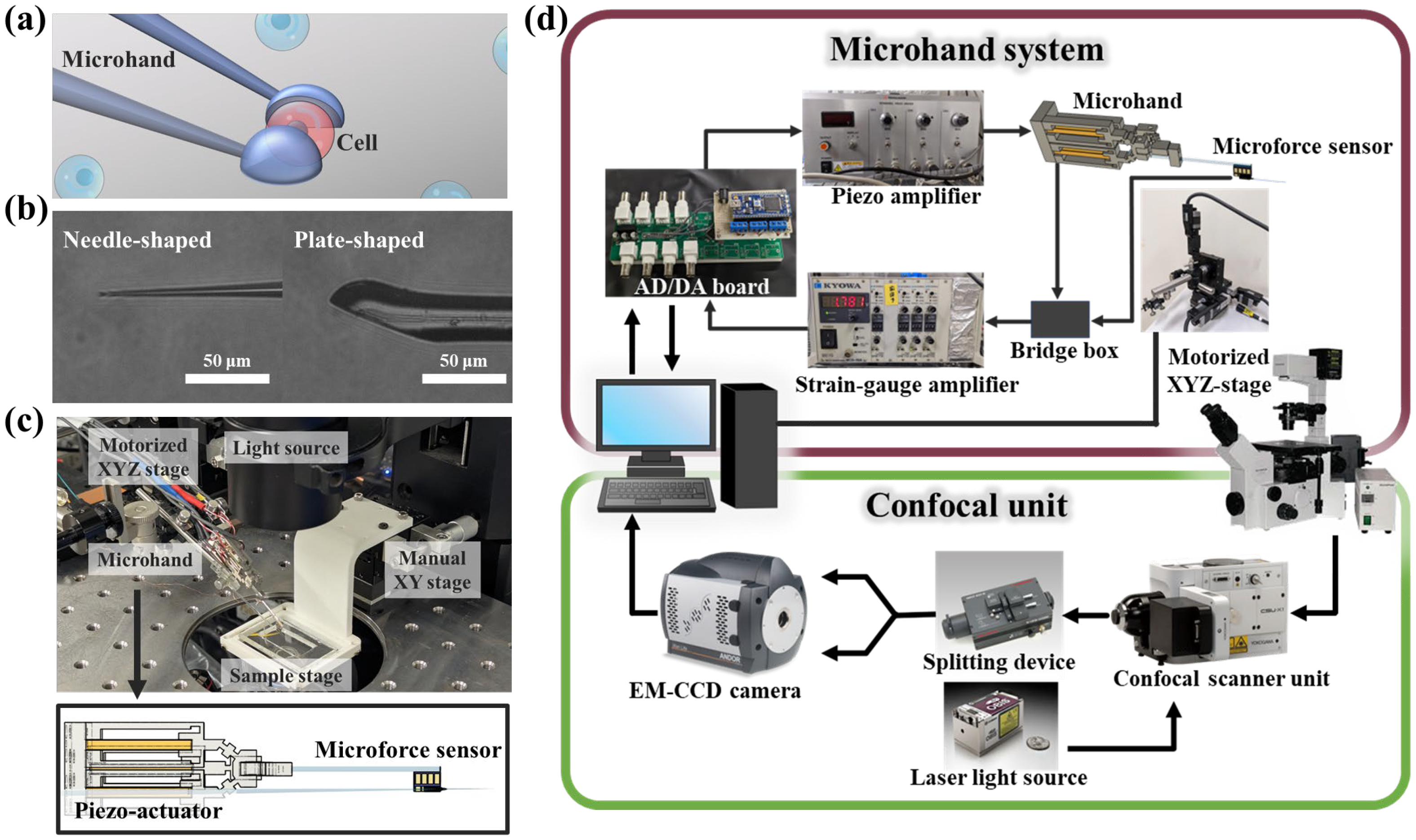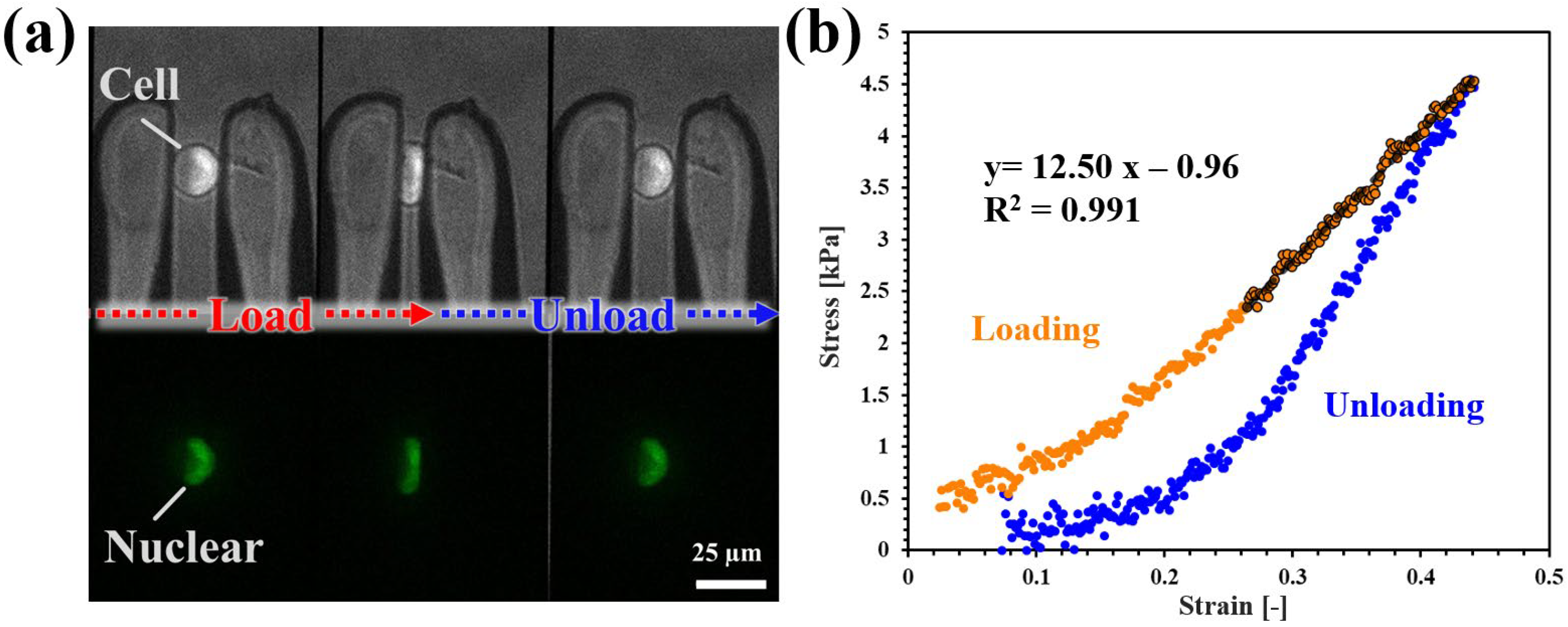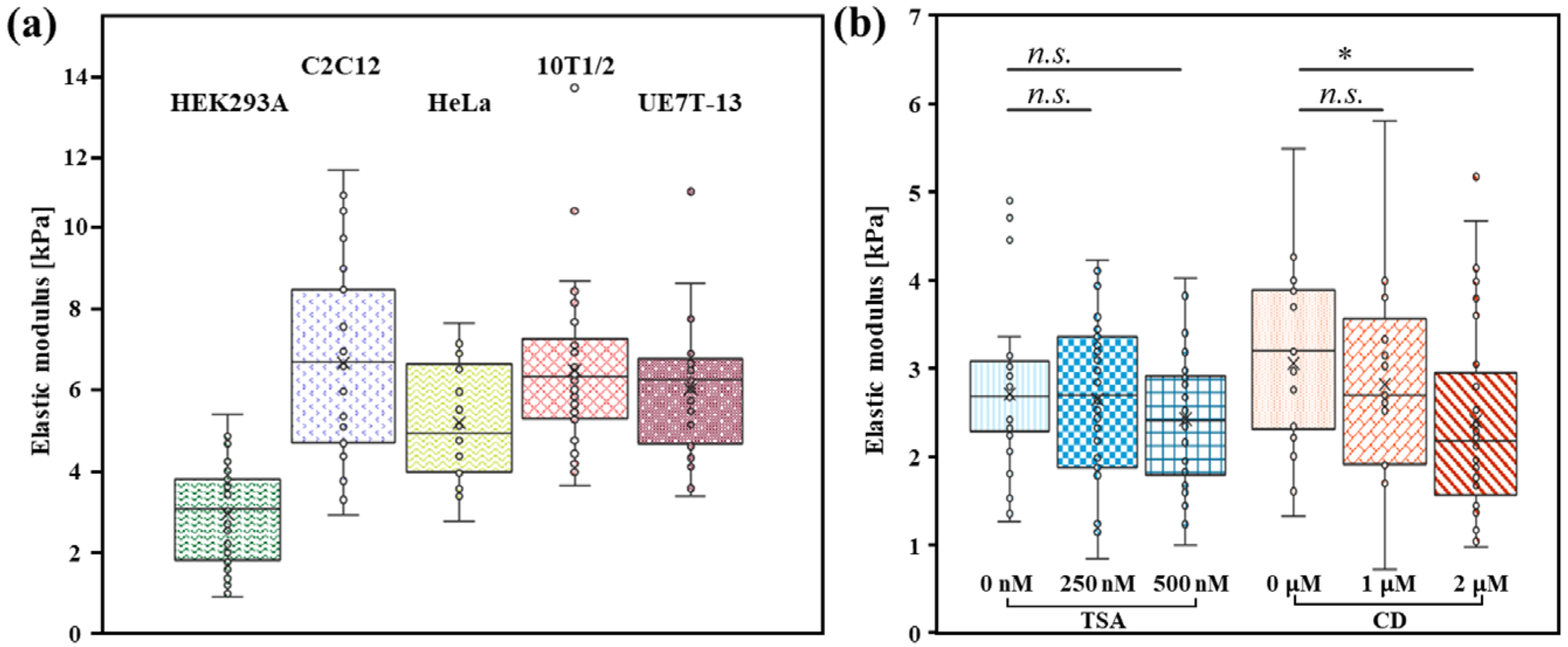Microhand Platform Equipped with Plate-Shaped End-Effectors Enables Precise Probing of Intracellular Structure Contribution to Whole-Cell Mechanical Properties
Abstract
1. Introduction
2. Materials and Methods
2.1. System Configuration
2.2. Fabrication of End-Effectors and Microforce Sensors
2.3. Automated Calibration Method for Microforce Sensors
2.4. Materials
2.5. Cell Culture Condition
2.6. Staining Process of Cells
2.7. Overexpression of Lamin A and Progerin
2.8. Stiffness Measurement of Individual Cells
2.9. Statistical Analysis
3. Results and Discussion
3.1. Automation of Microforce Sensors Calibration
3.2. Effect of End-Effector Shape on Cell Stiffness Measurement
3.3. Mechanical Properties of Different Cell Types
3.4. Comparison of HEK293A Cell Stiffness After Different Drug Treatments
3.5. Altered Mechanical Characteristics in HGPS Model Cells
3.6. Viscoelastic Properties of HEK293A Cells at Different Indentation Speed
4. Conclusions
Supplementary Materials
Author Contributions
Funding
Data Availability Statement
Acknowledgments
Conflicts of Interest
References
- Pajerowski, J.D.; Dahl, K.N.; Zhong, F.L.; Sammak, P.J.; Discher, D.E. Physical plasticity of the nucleus in stem cell distribution. Biol. Sci. 2007, 104, 15619–15624. [Google Scholar] [CrossRef]
- Orzechowska, B.; Pabijan, J.; Wiltowska-Zuber, J.; Zemła, J.; Lekka, M. Fibroblasts change spreading capability and mechanical properties in a direct interaction with keratinocytes in conditions mimicking wound healing. J. Biomech. 2018, 74, 134–142. [Google Scholar] [CrossRef] [PubMed]
- Luo, Q.; Kuang, D.; Zhang, B.; Song, G. Cell stiffness determined by atomic force microscopy and its correlation with cell motility. Biochim. Biophys. Acta 2016, 1860, 1953–1960. [Google Scholar] [CrossRef]
- Li, M.; Peng, L.; Wang, Z.; Liu, L.; Cao, M.; Cui, J.; Wu, F. Roles of the cytoskeleton in human diseases. Mol. Biol. Rep. 2023, 50, 2847–2856. [Google Scholar] [CrossRef]
- Tsujita, K.; Satow, R.; Asada, S.; Nakamura, Y.; Arnes, L.; Sako, K.; Fujita, Y.; Fukami, K.; Itoh, T. Homeostatic membrane tension constrains cancer cell dissemination by counteracting BAR protein assembly. Nat. Commun. 2021, 12, 5930. [Google Scholar] [CrossRef] [PubMed]
- Islam, M.; Raj, A.; McFarland, B.; Brink, H.M.; Ciciliano, J.; Fay, M.; Myers, D.R.; Flowers, C.; Waller, E.K.; Lam, W.; et al. Stiffness based enrichment of leukemia cells using microfluidics. APL Bioeng. 2020, 4, 036101. [Google Scholar] [CrossRef] [PubMed]
- Rosenblut, M.J.; Lam, W.A.; Fletcher, D.A. Analyzing cell mechanics in hematologic diseases with microfluidic biophysical flow cytometry. Lab A Chip 2008, 8, 1062–1070. [Google Scholar] [CrossRef] [PubMed]
- Lammerding, J.; Schulze, P.C.; Takahashi, T.; Kozlov, S.; Sullivan, T.; Kamm, R.D.; Stewart, C.L.; Lee, R.T. Lamin A/C deficiency causes defective nuclear mechanics and mechanotransduction. J. Clin. Investig. 2004, 113, 370–378. [Google Scholar] [CrossRef]
- Hennekam, R.C.M. Hutchinson–Gilford progeria syndrome: Review of the phenotype. Am. J. Med. Genet. Part A 2006, 140, 2603–2624. [Google Scholar] [CrossRef] [PubMed]
- Lammerding, J.; Hsiao, J.; Schulze, P.C.; Kozlov, S.; Stewart, C.L.; Lee, R.T. Abnormal nuclear shape and impaired mechanotransduction in emerin-deficient cells. J. Cell Biol. 2005, 170, 781–791. [Google Scholar] [CrossRef]
- Apte, K.; Stick, R.; Radmacher, M. Mechanics in human fibroblasts and progeria: Lamin A mutation E145K results in stiffening of nuclei. J. Mol. Recognit. 2017, 30, e2580. [Google Scholar] [CrossRef]
- Verstraeten, V.L.; Ji, J.Y.; Cummings, K.S.; Lee, R.T.; Lammerding, J. Increased mechanosensitivity and nuclear stiffness in Hutchinson–Gilford progeria cells: Effects of farnesyltransferase inhibitors. Aging Cell 2008, 7, 383–393. [Google Scholar] [CrossRef] [PubMed]
- Wu, P.H.; Aroush, D.R.; Asnacios, A.; Chen, W.; Dokukin, M.E.; Doss, B.L.; Durand-Smet, P.; Ekpenyong, A.; Guck, J.; Guz, N.V.; et al. A comparison of methods to assess cell mechanical properties. Nat. Methods 2018, 15, 491–498. [Google Scholar] [CrossRef] [PubMed]
- Hao, Y.; Cheng, S.; Tanaka, Y.; Hosokawa, Y.; Yalikun, Y.; Li, M. Mechanical properties of single cells: Measurement methods and applications. Biotechnol. Adv. 2020, 45, 107648. [Google Scholar] [CrossRef] [PubMed]
- Hochmuth, R.M. Micropipette aspiration of living cells. J. Biomech. 2000, 33, 15–22. [Google Scholar] [CrossRef] [PubMed]
- Miyazaki, H.; Hasegawa, Y.; Hayashi, K. Tensile Properties of Contractile and Synthetic Vascular Smooth Muscle Cells. JSME Int. J. Ser. C Mech. Syst. Mach. Elem. Manuf. 2002, 45, 870–879. [Google Scholar] [CrossRef]
- Sugiura, H.; Sakuma, S.; Kaneko, M.; Arai, F. On-Chip Method to Measure Mechanical Characteristics of a Single Cell by Using Moiré Fringe. Micromachines 2015, 6, 660–673. [Google Scholar] [CrossRef]
- Lekka, M. Discrimination Between Normal and Cancerous Cells Using AFM. BioNanoScience 2016, 6, 65–80. [Google Scholar] [CrossRef]
- Chen, J.; Irianto, J.; Inamdar, S.; Pravincumar, P.; Lee, D.A.; Bader, D.L.; Knight, M.M. Cell Mechanics, Structure, and Function Are Regulated by the Stiffness of the Three-Dimensional Microenvironment. Biophys. J. 2012, 103, 1188–1197. [Google Scholar] [CrossRef]
- Caille, N.; Thoumine, O.; Tardy, Y.; Meister, J. Contribution of the nucleus to the mechanical properties of endothelial cells. J. Biomech. 2002, 35, 177–187. [Google Scholar] [CrossRef]
- Hu, M.; Wang, J.; Zhao, H.; Dong, S.; Cai, J. Nanostructure and nanomechanics analysis of lymphocyte using AFM: From resting, activated to apoptosis. J. Biomech. 2009, 42, 1513–1519. [Google Scholar] [CrossRef]
- Yousafzai, M.S.; Coceano, G.; Mariutti, A.; Ndoye, F.; Amin, L.; Niemela, J.; Bonin, S.; Scoles, G.; Cojoc, D. Effect of neighboring cells on cell stiffness measured by optical tweezers indentation. J. Biomed. Opt. 2016, 2, 057004. [Google Scholar] [CrossRef] [PubMed]
- Chang, D.; Sakuma, S.; Kera, K.; Uozumi, N.; Arai, F. Measurement of the mechanical properties of single Synechocystis sp. strain PCC6803 cells in different osmotic concentrations using a robot-integrated microfluidic chip. Lab A Chip 2018, 18, 1241–1249. [Google Scholar] [CrossRef]
- Castro, A.B. Optical Tweezers: Phototoxicity and Thermal Stress in Cells and Biomolecules. Micromachines 2019, 10, 507. [Google Scholar] [CrossRef]
- Hagiwara, M.; Kawahara, T.; Yamanishi, Y.; Masuda, T.; Fwngt, L.; Arai, F. On-chip magnetically actuated robot with ultrasonic vibration for single cell manipulations. R. Soc. Chem. 2011, 11, 2049–2054. [Google Scholar] [CrossRef] [PubMed]
- Étienne, J.; Fouchard, J.; Mitrossilis, D.; Bufi, N.; Durand-Smet, P.; Asnacios, A. Cells as liquid motors: Mechanosensitivity emerges from collective dynamics of actomyosin cortex. Biophys. Comput. Biol. 2015, 112, 2740–2745. [Google Scholar] [CrossRef]
- Kawakami, M.; Kojima, M.; Masuda, Y.; Mae, Y.; Horii, T.; Nagai, T.; Nakahata, M.; Sakai, S.; Arai, T. Automated Microhand System for Measuring Cell Stiffness By Using Two Plate End-Effectors. IEEE Robot. Autom. Lett. 2022, 7, 2385–2390. [Google Scholar] [CrossRef]
- Ohara, K.; Kawakami, D.; Takubo, T.; Mae, Y.; Tanikawa, T.; Honda, A.; Arai, T. Dextrous cell diagnosis using two-fingered microhand with force sensor. J. Micro-Nano Mechatron. 2012, 7, 13–20. [Google Scholar] [CrossRef]
- Inoue, K.; Tanikawa, T.; Arai, T. Micro-manipulation system with a two-fingered micro-hand and its potential application in bioscience. J. Biotechnol. 2008, 133, 219–224. [Google Scholar] [CrossRef]
- Li, M.; Liu, L.; Xiao, X.; Xi, N.; Wang, Y. Effects of methotrexate on the viscoelastic properties of single cells probed by atomic force microscopy. J. Biol. Phys. 2016, 42, 551–569. [Google Scholar] [CrossRef]
- Hayashi, K.; Iwata, M. Stiffness of cancer cells measured with an AFM indentation method. J. Mech. Behav. Biomed. Mater. 2015, 49, 105–111. [Google Scholar] [CrossRef]
- Saito, S.; Hori, M.; Ozaki, H.; Karaki, H. Cytochalasin D Inhibits Smooth Muscle Contraction by Directly Inhibiting Contractile Apparatus. J. Smooth Muscle Res. 1996, 32, 51–60. [Google Scholar] [CrossRef]
- Haghparast, S.M.A.; Kihara, T.; Miyake, J. Distinct mechanical behavior of HEK293 cells in adherent and suspended states. PeerJ 2015, 3, e1131. [Google Scholar] [CrossRef]
- Struhl, K. Histone acetylation and transcriptional regulatory mechanisms. Genes Dev. 1998, 12, 599–606. [Google Scholar] [CrossRef]
- Heo, S.J.; Song, K.H.; Thakur, S.; Miller, L.M.; Cao, X.; Peredo, A.P.; Seiber, B.N.; Qu, F.; Driscoll, T.P.; Shenoy, V.B.; et al. Nuclear softening expedites interstitial cell migration in fibrous networks and dense connective tissues. Sci. Adv. 2020, 6, eaax5083. [Google Scholar] [CrossRef] [PubMed]
- Shimamoto, Y.; Tamura, S.; Masumoto, H.; Maeshima, K. Nucleosome-nucleosome interactions via histone tails and linker DNA regulate nuclear rigidity. Mol. Biol. Cell 2017, 28, 1580–1589. [Google Scholar] [CrossRef] [PubMed]
- Kurashina, Y.; Hirano, M.; Imashiro, C.; Totani, K.; Komotori, J.; Takemura, K. Enzyme-free cell detachment mediated by resonance vibration with temperature modulation. Biotechnol. Bioeng. 2017, 114, 2279–2288. [Google Scholar] [CrossRef] [PubMed]
- Vertegel, P.; Milkin, P.; Murashko, A.; Parker, M.; Peranidze, K.; Emashova, N.; Minko, S.; Reukov, V. Cell detachment: A review of techniques, challenges, and opportunities for advancing biomedical research and applications. Prog. Biophys. Mol. Biol. 2025, 196, 50–68. [Google Scholar] [CrossRef]
- Lordon, B.; Campion, T.; Gibot, L.; Gallot, G. Impact of trypsin on cell cytoplasm during detachment of cells studied by terahertz sensing. Biophys. J. 2024, 123, 2476–2483. [Google Scholar] [CrossRef]
- Rusinol, A.E.; Sinensky, M.S. Farnesylated lamins, progeroid syndromes and farnesyl transferase inhibitors. J. Cell Sci. 2006, 119, 3265–3272. [Google Scholar] [CrossRef]
- Worman, H.J.; Michaelis, S. Permanently Farnesylated Prelamin A, Progeria, and Atherosclerosis. Circulation 2018, 138, 283–286. [Google Scholar] [CrossRef] [PubMed]
- Danielsson, B.E.; Peters, H.C.; Bathula, K.; Spear, L.M.; Noll, N.A.; Dahl, K.N.; Conway, D.E. Progerin-expressing endothelial cells are unable to adapt to shear stress. Biophys. J. 2022, 121, 620–628. [Google Scholar] [CrossRef] [PubMed]
- Bidault, G.; Garcia, M.; Capeau, J.; Morichon, R.; Vigouroux, C.; Béréziat, V. Progerin, Expression Induces Inflammation, Oxidative Stress and Senescence in Human Coronary Endothelial Cells. Cells 2020, 9, 1201. [Google Scholar] [CrossRef]
- Takahashi, Y.; Hiratsuka, S.; Machida, N.; Takahashi, D.; Matsushita, J.; Hozak, P.; Misteli, T.; Miyamoto, K.; Harata, M. Impairment of nuclear F-actin formation and its relevance to cellular phenotypes in Hutchinson-Gilford progeria syndrome. Nucleus 2020, 11, 250–263. [Google Scholar] [CrossRef]
- Osmanagic-Myers, S.; Kiss, A.; Manakanatas, C.; Hamza, O.; Sedlmayer, F.; Szabo, P.L.; Fichtinger, I.F.P.; Podesser, B.K.; Erilsson, M.; Foisner, R. Endothelial progerin expression causes cardiovascular pathology through an impaired mechanoresponse. J. Clin. Investig. 2019, 129, 531–545. [Google Scholar] [CrossRef]
- Lange, J.R.; Steinwachs, J.; Kolb, T.; Lautscham, L.A.; Harder, I.; Whyte, G.; Fabry, B. Microconstriction Arrays for High-Throughput Quantitative Measurements of Cell Mechanical Properties. Biophys. J. 2015, 109, 26–34. [Google Scholar] [CrossRef]
- Booth, E.A.; Spagnol, S.T.; Alcoser, T.A.; Dahl, K.N. Nuclear stiffening and chromatin softening with progerin expression leads to an attenuated nuclear response to force. Soft Matter 2015, 11, 6412–6418. [Google Scholar] [CrossRef]
- Lima, I.V.M.; Silva, A.V.S.; Sousa, F.D.; Ferreira, W.P.; Freire, R.S.; de Oliveira, C.L.N.; de Sousa, J.S. Measuring the viscoelastic relaxation function of cells with a time-dependent interpretation of the Hertz-Sneddon indentation model. Heliyon 2024, 10, e30623. [Google Scholar] [CrossRef] [PubMed]







| Manual Method [28] | Automated Method | |
|---|---|---|
| RMSE [nN] | 3.87 | 5.38 |
| Maximum error [nN] | 25.4 | 10.7 |
Disclaimer/Publisher’s Note: The statements, opinions and data contained in all publications are solely those of the individual author(s) and contributor(s) and not of MDPI and/or the editor(s). MDPI and/or the editor(s) disclaim responsibility for any injury to people or property resulting from any ideas, methods, instructions or products referred to in the content. |
© 2025 by the authors. Licensee MDPI, Basel, Switzerland. This article is an open access article distributed under the terms and conditions of the Creative Commons Attribution (CC BY) license (https://creativecommons.org/licenses/by/4.0/).
Share and Cite
Kawakami, M.; Kojima, M.; Ogura, T.; Kubo, A.; Arai, T.; Sakai, S. Microhand Platform Equipped with Plate-Shaped End-Effectors Enables Precise Probing of Intracellular Structure Contribution to Whole-Cell Mechanical Properties. Micromachines 2025, 16, 1272. https://doi.org/10.3390/mi16111272
Kawakami M, Kojima M, Ogura T, Kubo A, Arai T, Sakai S. Microhand Platform Equipped with Plate-Shaped End-Effectors Enables Precise Probing of Intracellular Structure Contribution to Whole-Cell Mechanical Properties. Micromachines. 2025; 16(11):1272. https://doi.org/10.3390/mi16111272
Chicago/Turabian StyleKawakami, Masahiro, Masaru Kojima, Toshihiko Ogura, Atsushi Kubo, Tatsuo Arai, and Shinji Sakai. 2025. "Microhand Platform Equipped with Plate-Shaped End-Effectors Enables Precise Probing of Intracellular Structure Contribution to Whole-Cell Mechanical Properties" Micromachines 16, no. 11: 1272. https://doi.org/10.3390/mi16111272
APA StyleKawakami, M., Kojima, M., Ogura, T., Kubo, A., Arai, T., & Sakai, S. (2025). Microhand Platform Equipped with Plate-Shaped End-Effectors Enables Precise Probing of Intracellular Structure Contribution to Whole-Cell Mechanical Properties. Micromachines, 16(11), 1272. https://doi.org/10.3390/mi16111272







